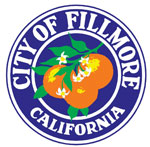 Gerardo Rodriguez being put into a police car after a brief pursuit last Sunday afternoon. Enlarge Photo By Anonymous — Wednesday, November 5th, 2008
Gerardo Rodriguez, age 24, of Fillmore, was arrested Sunday, November 2, after a brief police vehicle pursuit, then on foot. At approximately 3:45 p.m. Rodriguez was arrested by Mountain View. He has been charged with evading arrest, resisting arrest, under the influence, and two (2) counts felony child endangerment. Bail has been set at $50,000 for each child endangerment felony count. There were numerous outstanding warrants on Rodriguez at he time of his most current arrest. |
|
By Joyce Schifanelli — Wednesday, November 5th, 2008
Part Two
Joseph D. McNab’s farseeing vision of Fillmore in the late 1800s and the town’s early success in business and ranching was a product of a splendid, bountiful valley of Prime agricultural soil, sound planning, and the determined pioneering spirit of its settlers. Trains, the engine responsible for opening the area, carried passengers and freight through the valley and beyond. With accessible transportation, Fillmore’s reputation grew as a great place to earn a good living and raise a family. Nevertheless, with increasing popularity of automobiles in the early decades of the twentieth century, passenger train service decreased. The last passenger train stopped at our station on January 13, 1935, marking the end of an exciting era, and refrigerated trucks soon replaced freight trains laden with the fruits of our valley. Alas, the Southern Pacific Company closed down the Fillmore stop in 1974. Today, the recently restored train depot, an integral part of our town’s initial growth, is part of the Fillmore Historical Museum. The stop, utilized by the Fillmore and Western Railway, is also the scene for many Hollywood productions. Besides the booming citrus, walnut, apricot, row crops and honey industries of the early days, Ventura County was known as the “Mother of Oil”. The Union Oil Co. drilled shallow wells within sight of the Fillmore site, beyond the end of Sespe Ave. as early as 1880. Hundreds of deeper wells and numerous oil companies were in operation by 1911, creating a multitude of jobs. In 1924, the Ventura Refinery became the Fillmore Texaco Refinery also employing many locals during the decades. Despite extensive leasing and a minor oil boom, the refinery closed in 1950, too small to be economical in meeting production demands of the many types of oil used in a modern society. These days, the refinery is utilized as a pumping station. In an ad in the September 18, 1958 issue of the Fillmore Herald, Standard Oil declared, “The United States will use more oil in the next fifteen years than we did in the last one-hundred.” And, that the company is “reinvesting a big share of our income in the never ending search for petroleum to meet the growing needs of motorists, industry, homeowners, farms and the Armed Services.” Many area oil fields such as the Shiells Canyon Field (the biggest field close to Fillmore), Sespe Oil Field, Torrey Field and Elkins Field are still in operation however, overall oil production has decreased 23% statewide since 1996. There are far fewer jobs in the oil fields than there were a half century ago. CONTINUED » |
|
By Anonymous — Wednesday, November 5th, 2008
Former Fillmore Mayor Mike McMahan, 51, was arrested, cited and released on Tuesday, November 3rd at approximately 4:15 p.m. at his First Street residence, according to Ventura Sheriff Public Information Officer Ross Bonfiglio. McMahan was cited after witnesses called the Sheriffs department complaining that McMahan had stolen ‘Vote Yes on Proposition 8’ signs from private and/or public property. |
|
By Anonymous — Wednesday, November 5th, 2008
FILLMORE City Council FILLMORE Unified SD - Gov Brd Mem. FILLMORE City Clerk FILLMORE City Treasurer Measure H City of Fillmore North Specific Plan Ref Measure I City of Fillmore General Plan Amendment Measure M Piru Cemetary Maint. |
|
By Anonymous — Tuesday, November 4th, 2008
FILLMORE City Council FILLMORE Unified SD - Gov Brd Mem. FILLMORE City Clerk FILLMORE City Treasurer Measure H City of Fillmore North Specific Plan Ref Measure I City of Fillmore General Plan Amendment |
|
By Anonymous — Tuesday, November 4th, 2008
Happy Election Day! For up to the minute election results, please visit us online right here starting tonight at approximately 8pm. P.S. Don't forget to vote! The Ventura County Recorders Office provides a very easy to use tool to locate exactly where to vote. It can be found at this link. Click here to find out where to vote |
|
By Anonymous — Wednesday, October 29th, 2008
Major Bill Edmonds, a 1989 graduate of Fillmore High is currently taking a course of study at the Naval Post Graduate School in Monterrey. He will graduate in December with a Masters in Military Tactics and Strategy. His Masters thesis is on Profiling Terrorists. Major Edmonds is in Special Forces. He recently returned from a tour in Iraq where he served in Mosul. Major Edmonds and his wife Cheryl will return to Washington for more intensive study at the |
 At Tuesday night city council meeting Mayor Steve Conaway presented a proclamation to Pearl Lee Broughton, for her invaluable volunteer service to the Senior Center. Pictured (l-r) Annette Cardona, Pearl Lee Broughton, Mayor Steve Conaway, and Lori Nunez. Enlarge Photo By Mariandrea Mueller — Wednesday, October 29th, 2008
Fillmore City Council met October 28th at 6:30 p.m. at City Hall. The Council honored Pearl Lee Broughton and the employee of the quarter, heard a presentation on Chloride Control, and prioritized improvements to support downtown businesses. The Council approved a draft of the City's housing element to be submitted on October 29, 2008. There will be a public workshop explaining the housing element and soliciting public comments on the draft on November 18th. The draft will be under review for 60 days after submission. Modifications are expected. The housing element draft is posted on the Fillmore City website (http://www.fillmoreca.com/) in the Planning Department section. Studies included an Agricultural Threshold Study, a Threatened and Endangered Species Study, an Anti-degradation Analysis, and a Groundwater Surface Water Interaction Model. The Ag study found that avocados were more sensitive to salt levels than strawberries and nursery crops. Avocados can be damaged if chloride levels reach over 117 milligrams/Liter. Studies showed that threatened and endangered species were less sensitive than avocados. Therefore, the SCSD is requesting Site Specific Objectives (SSO) for water quality in the Upper Santa Clara River area between Piru Creek and the Saugus Water Reclamation Plant (WRP). The Water Quality Objectives call for a chloride limit of 100 mg/L. SCSD, with the support of UW, will request a limit of 150 mg/L in the area between the Ventura/LA County line and the Valencia WRP, and will request a limit of 117-130 mg/L in the area (known as "Reach 4B") between the Ventura/LA County line and Piru Creek. 117 mg/L would be the usual limit and the 130 mg/L would only apply in times of drought, when the State water supply would have higher levels of chloride. Camulos Ranch is the only agricultural site within Reach 4B, and it would be provided with a separate water supply if the 117 mg/L limit was breached. CONTINUED » |
 Shown (l-r) are Captain Tim Hagel, Sheriff Bob Brooks, JDRF Official Captain Randy Pentis, Undersheriff Craig Husband, and Sergeant Joe Devorick. Enlarge Photo By Anonymous — Wednesday, October 29th, 2008
Sheriff Bob Brooks presented a check for $10,000 Thursday morning, Oct. 16th, for the Juvenile Diabetes Research Foundation on behalf of Cops Running For Charity, which is a team of sheriff’s deputies who compete in physical endurance challenges throughout the world to raise money for a variety of medical charities. The presentation took place at the Sheriff’s Dept. Shooting Range in Camarillo. The group recently ran a 35- mile ultra-marathon course across the volcanic landscape in Iceland. In 2007, the team ran a marathon on the steps of China’s Great Wall, and in 2006, they trudged across the dunes of the Sahara Desert in Tunisia in a grueling 70-mile race. Each race has been a physical and mental test for the team. Their focus in each race has been giving back to the communities they serve. The group has raised thousands of dollars for medical charities, including Children’s Hospital Los Angeles, the Make-A-Wish Foundation, the American Cancer Society, Lou Gehrig’s Disease (ALS), Hospice, and Alzheimer’s. During Thursday’s event, Sheriff Brooks will also present a $2,500.00 check to ALS on behalf of Detective Sergeant Joe Devorick’s father, who was a sergeant with the Oxnard Police Department and died of ALS two years after his retirement. The group recently presented a $5,000.00 check to Children’s Hospital Los Angeles. Members of CRFC will be available at Thursday’s event to answer questions about their unique adventures and to explain their motivation for helping the community. Officer Preparing Release: Senior Deputy Eric Buschow. |
|
By Joyce Schifanelli — Wednesday, October 29th, 2008
Part 1
Southern California was a busy time in the late 1800’s. With the coming of the railroad, and regularly scheduled freight and passenger train service available from Los Angeles to Santa Paula in early 1887, real estate prices boomed and the pioneer spirit prevailed in little villages and settlements nestled in the sheep and cattle country of the magnificent wild mustard covered Santa Clara Valley. Advertisements in the Los Angeles Times, train excursions and barbecues all served to lure Angelinos and others to the developing area. Our town’s formal beginnings go back to 1887 when visionary, Joseph D. McNab of the Sespe Land and Water Company convinced the Southern Pacific Railroad to establish a stop on the Fillmore site in lieu of the Cienega area site, east of the fish hatchery, Bardsdale, or the Sespe area, west of Sespe Creek. McNab was also instrumental in much of the infant town’s early activities and development, which included laying out the future city’s plans and hiring William Mullholland from Los Angeles to develop a wooden flume system, bringing essential water from upper Sespe Creek. Named in honor of Jerome A. Fillmore, a Southern Pacific General Superintendent, the town’s first street map was recorded in 1888 at the Ventura County Court House. By 1900, Fillmore boasted 150 citizens (Rand McNally Atlas). In 1958, a half century ago, the recorded population had grown to 4,725. Today, approximately 14,000 men, women and children call Fillmore home. Growth, change and disaster have touched Fillmore through the decades. During Fillmore’s early days, businesses sprung up on either side of the railroad right-of-way near the depot on Main Street, the original main street. The first businesses, all wooden structures, included a rooming house, pool hall, general store, saloon, lumberyard, fruit stand, and barbershop, servicing the needs of rail passengers and residents alike. Dozens of other businesses including a newspaper, theatre, olive oil factory and an inn spread east down Main and along Fillmore Street. Fruit packinghouses, warehouses and corrals for cattle were located east of the depot. The railroad company owned a gravel pit, employing one hundred Chinese laborers loading cars of gravel. They lived in a tent village on the edge of town and traded with local merchants. The Ventura Free Press applauded Fillmore’s acumen, serving the Santa Clara Valley in 1899 citing numerous service and goods businesses, two churches, grammar school, large public hall, Justice of the Peace, Constable and Deputy Sheriff, three notary publics, and an insurance and real estate agent. Other businesses included The Sespe Land and Water Co., Fillmore Irrigation Co., Sunset Telephone and Telegraph Co., Excelsior Laundry, on site representatives of Wells Fargo and Western Union Telegraph Co., and a stockyard with facilities to ship cattle. CONTINUED » |






